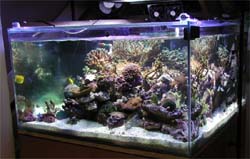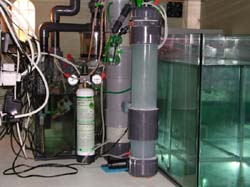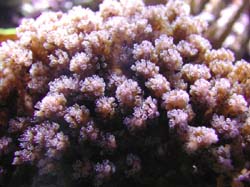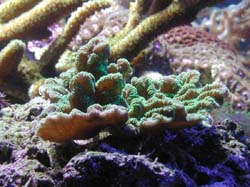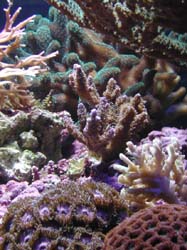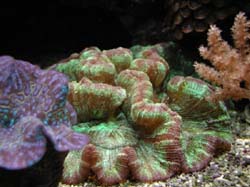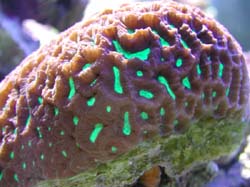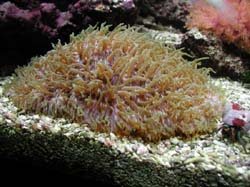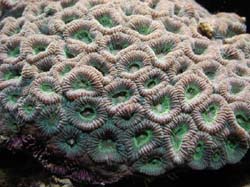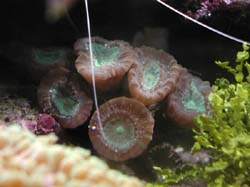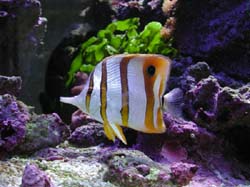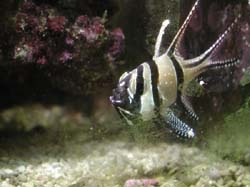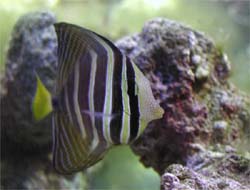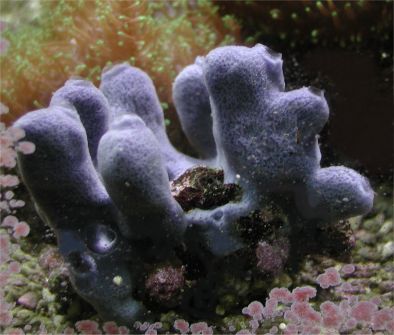Cet article est paru en Août 2002 sur le site ’Advanced Aquarist’. Il décrit la configuration du bac à cette époque, configuration qui a depuis largement évoluée.
I would like to start with an important note: this aquarium is only four months old. Its stability and long-term success are not yet proven, even if nearly all the livestock (fish, corals, part of the live rock and sand, etc …) have been transferred from my previously successful 2-1/2 year old setup (300 l – 80 Gal.).
Le Bac à Léon
I set up this aquarium for many reasons, but its probable success can be linked to the friendliness and passion of a few persons who, since then, became personal friends. These persons will know who they are, and are all members of Aquarium Récifal, l’Association (ARA), probably the most relevant and dynamic association in France today.
The “Berlin Method” dictates the maintenance of this aquarium. The only major exception to the rule is the use of a relatively thick sand bed about 5 cm deep. Part of it was transferred as “live” sand from my previous setup, and I added about 50 kg of dead sand composed of crushed coral skeletons (Aquarium systems, fine grade). Real live sand is unfortunately not available in France, oolithic grade costs an arm and a leg, so I couldn’t create a true Deep Sand Bed as defined in the U.S.
This sand bed serves two purposes, first increase biodiversity by providing a habitat for various critters, and then help complete the Nitrogen cycle.
Moreover, my personal aesthetic taste prefers a sand bed compared to a bare bottom.
The dimensions of this 800 liter tank (210 Gal. – 120 x 120 x 65 cm ~ 4′ x 4′ x 2′) are ideal in order to create a circular water movement. A single 400W metal halide pendant provides lighting.
This tank, its stand, and nearly all the other components, are a result of DIY work. It is probably the best way to learn and understand how everything works … and I like doing things with my hands !
The overflow is a Durso standpipe. This system is simple and reliable and the tank is, at last, completely silent.
A 150 liters sump hosts the skimmer, the heater and the return pump.
The fresh water reserve holds 120 liters, enough for about 10 days of autonomy for water top-off.
The last element of the system is the 40 liter refugium. It is set up in a very simple way, with 6 to 7 cm of oolithic sand, Caulerpa spp., snails, a few crabs, etc … A few months after its setup it is full of life.
Feeding
- 3 frozen cubes per day (Artemia sp. Krill, spinach)
- dried seaweed 2-3 times per week
- flakes, once in a while.
Filtration
Live rock (100 kg for 800 liters ~ 220 lbs for 211 Gal.) and a needle-wheel skimmer (H&S 150-F2001, 38W Aquabee pump) provide water filtration. 2,300 ml of carbon are used and changed every three months.
Water movement
Two Hagen AquaClear 5000 power heads (3,800 l/h ~ 1,000 Gal./h) and Two Eheim 1060 pumps (2,200 l/h ~ 600 Gal./h) provide water movement. The pumps are switched on and off, in turns, every 2 hours, creating an alternated circular movement in the aquarium. Areas of intense and lower energy levels are created, making it easy to find a good spot for any type of coral. The power heads are stopped during the night, circulation is then only provided by the Eheim pumps.
Sump return
One Eheim 1060 pump (2,200 l/h ~ 600 Gal./h) returns the water from the sump back to the aquarium.
Lighting
A single 400 Watts BLV/Ushio HITlite 10,000 K metal halide (10 hours per day) and two 36 Watts Osram 67 blue tubes (12 hours per day) are providing lighting at the moment. I will probably add the metal halides from the previous setup at a later stage.
Water top-off
I built the water top-off system using a pump from a car’s windscreen washer and float switches. Only reverse osmosis water is used, going through a Nilsen calcium reactor, and is slowly and continuously dripped.
Calcium Reactors
I use two methods to provide calcium and maintain alkalinity :
- DIY Nilsen reactors, using a mixing pump instead of a magnetic stirrer. You can find the plans here
- DIY CaCO3/CO2 reactor. Flow is 2 l/h (~ 0.5 Gal./h) with 1 CO2 bubble per second. The substrate used is crushed corals. I never detected any phosphates in the water.
Cooling
I use two 4″ PC fans, using a 10 V power supply. The maximum measured temperature in the tank was 28°C (82°F). The stand containing the sump is as well equipped with a PC fan.
Automation
A programmable robot manages all the aquarium’s functions (lighting, water movement cycles, water top-off timing, Nilsen reactor mixing, cooling, feeding pause for the pumps, etc …).
The same robot manages security features as well. It will stop the return pump when the water level is too low in the sump, stop top-off when the water reserve is empty, start a secondary top-off pump if the main one failed, etc …
The robot is a Zelio from Télémécanique. It is very easy to program using a symbolic language, from a module running on a PC, by drawing the electrical diagram on the screen. The program is then downloaded into the module using a serial cable.
This solution avoids the tedious cabling of relays, pumps, sensors, timers, etc … It allows extreme liberty and provides a great answer to problems that are difficult to solve by using usual cabling. It also avoids the use of a soldering iron when you do modifications. I think that my system is much more flexible than the dedicated units found on the market.
Parameters
- Temperature : 27-28°C ~ 80.6-82.4°F
- NO2 : 0
- NO3 :5 mg/l
- Ca: 350 mg/l (target: 450 mg/l)
- dKH : 8 (2.8 meq/l)
- Mg: 1250 mg/l
- PO4: not detected
- Salinity: 35ppt
Supplements
I use very little sumplementation at this time, due to the young age of the aquarium. My previous setup was using the calcium reactor (CaCO3/CO2 reactors are supposed to bring Strontium and other elements) as well as iodine and other trace elements … from time to time. The Nilsen reactor is reloaded with 4 spoonfuls of calcium hydroxide every week.
Corals
SPS
- Merulina ampliata
- Acroporas spp.(about 10 species)
- Pocillopora eydouxi
- Seriatopora spp. (hystrix and caliendrum)
- Hydnophora rigida
- Montipora sp. Forming concentric cups
- Turbinaria reniformis
- Pachyseris rugosa
LPS
- Cynarina lacrimalis (1)
- Trachyphyllia geoffroyi (1)
- Platygyra pini (1)
- Caulastra spp. (2)
- Favia sp. (1)
- Fungia sp. (1)
Soft
- Rhodactis spp.
- Discosoma spp. (red and blue)
- Zoanthus varies
- Pachyclavularia sp. (Briareum sp.)
- Xenia spp.
- Lemnalia sp.
Fish
- Paracanthurus hepatus (1)
- Chromis viridis (12)
- Chelmon rostratus (1)
- Zebrasoma veliferum (1)
- Zebrasoma flavescens (1)
- Cerranus baldwini (1)
- 1 mated and breeding pair of Pterapogon kauderni (1)
- Labroides dimidiatus (1)
- Cryptocentrus cinctus with its Alpheus sp. Shrimp (1+1)
Other invertebrates
- Lysmata amboinensis (2)
- Stenopus hispidus (1)
- Hermit crabs (20)
- Serpent stars (4)
- Astrea sp.
- Trochus sp.
- Nerites
- Chiton
Miscellaneous
- Blue sponge (Haliclona Sp.)
- Halimeda sp. and other branched coralline algae
- Caulerpa spp. (2-3)
- Tridacna crocea (2)
Breeding
The ultimate target for an aquarium enthusiast (be that fresh or salt water) is to be able to breed its livestock.
I tried that with a pair of Pterapogon kauderni, and right after the second incubation phase, I ended up with about 20 youngsters in the refugium. Nearly all grew normally during the next few weeks, until I was able to give them away to other reef keepers in my neighborhood.
I would like to thank Nicolas Will for the translation from French to English and David Excoffier for his pictures; they are much sharper than mine.
You can follow the tank’s evolution on my web site lebacaleon.com.
